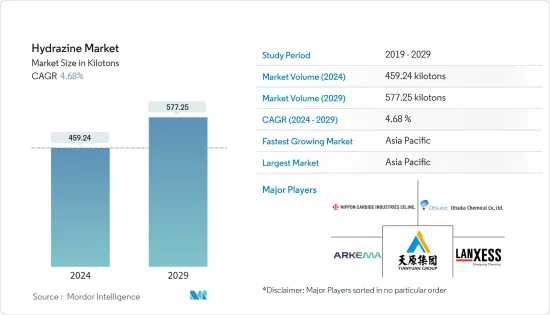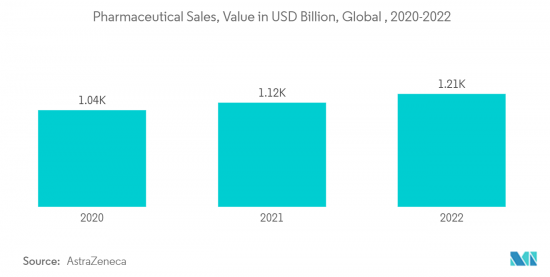PUBLISHER: Mordor Intelligence | PRODUCT CODE: 1406093

PUBLISHER: Mordor Intelligence | PRODUCT CODE: 1406093
Hydrazine - Market Share Analysis, Industry Trends & Statistics, Growth Forecasts 2024 - 2029

The Hydrazine Market size is estimated at 459.24 kilotons in 2024, and is expected to reach 577.25 kilotons by 2029, growing at a CAGR of 4.68% during the forecast period (2024-2029).
The market was negatively impacted by the COVID-19 pandemic as there was a slowdown in production and mobility, wherein agrochemical and other industries were forced to delay their production due to containment measures and economic disruptions. Currently, the market has recovered from the pandemic. The market reached pre-pandemic levels in 2022 and is expected to grow steadily in the future.
Key Highlights
- The major factor driving the market studied is the increasing demand from the agrochemical and pharmaceutical sectors.
- On the flip side, the highly toxic nature of hydrazine (such as it can cause skin burns, eye damage, etc.) is hindering the growth of the market.
- The use of hydrazine as an alternative to hydrogen in fuel cells is expected to offer various opportunities for the growth of the market.
- Asia-Pacific dominates the market across the world, with the largest consumption from countries such as China and India.
Hydrazine Market Trends
Increasing Demand from Pharmaceutical Sector
- Hydrazine is used as a precursor in several pharmaceutical applications. For example, hydrazine sulfate is used in the treatment of cancer and as a treatment for body wasting associated with cachexia disease.
- Further, Isoniazid, an antibiotic for the treatment of Tuberculosis, is prepared using hydrazine. According to the World Health Organization (WHO), the greatest number of Tuberculosis patients was found in six Asian countries, namely, India (27%), China (9%), Indonesia (8%), the Philippines (6%), Pakistan (6%), and Bangladesh (4%).
- The global pharmaceutical industry is currently driven by innovations and positive implications for the global population's health. The industry has been witnessing decent growth over the past several years.
- According to AstraZeneca, the global pharmaceutical sales in 2022 were USD 1,214 billion, representing a growth of 8.4% compared to the previous year.
- The United States, China, India, and Germany are the largest pharmaceutical industries in the world. CPHI (Convention on Pharmaceutical Ingredients) states that the United States remains the world's largest pharmaceutical market, accounting for 41% of global pharmaceutical spending.
- The United States is home to large pharmaceutical and biopharmaceutical companies, drug developers, and a center of innovation. Owing to years of investment in research and development, the industry is prepared to develop therapeutics and vaccines. Further, according to AstraZeneca, in 2022, the United States had 49.8% of global pharmaceutical sales.
- Therefore, owing to the above-mentioned factors, the market is expected to grow significantly during the forecast period.

Asia-Pacific to Dominate the Market
- The Asia-Pacific region is expected to account for the largest market for hydrazine during the forecast period owing to expanding pharmaceuticals and agrochemical industries.
- The pharmaceutical industry in China is also one of the largest in the world. The country produces generics, therapeutic medicines, active pharmaceutical ingredients, and traditional Chinese medicine.
- The government in China has implemented the "Healthy China 2030" initiative for developing the healthcare industry, which aims for the market to reach a value of USD 2.4 trillion by 2030.
- Furthermore, in August 2023, China's State Council released a 24-point list of guidelines aiming to improve the business environment for foreign investment which focuses on advancing Chinese healthcare and biopharma sectors.
- Further, in India, the pharmaceutical sector is also growing significantly. According to a report by Invest India, the pharmaceutical industry in India is anticipated to reach a market value of USD 65 billion by the year 2024, with further growth projected to reach USD 130 billion by 2030. Therefore, the PVP market is expected to rise in the region.
- Moreover, hydrazine is used as a precursor to many agrochemicals, involving fertilizers, pesticides, hormones, and plant growth regulators (PGR) that enable plant and soil protection, improve yield, and maintain and improve the growth process of plants.
- According to the Ministry of Chemicals and fertilizers (India), the pesticide production volume in 2022 accounted for 299 thousand metric tons in India, reflecting an increase of more than 17% compared to 2021. Thus boosting the market growth during the forecast period.
- Therefore, the above-mentioned factors indicate a positive influence of the growing agrochemical and pharmaceutical industry in the Asia-Pacific market on the studied market over the forecast period.
Hydrazine Industry Overview
The hydrazine market is fragmented in nature. The major players in the studied market (not in any particular order) include LANXESS, NIPPON CARBIDE INDUSTRIES CO. INC., Otsuka Chemical Co.,Ltd., Arkema, and Yibin Tianyuan Group, among others.
Additional Benefits:
- The market estimate (ME) sheet in Excel format
- 3 months of analyst support
TABLE OF CONTENTS
1 INTRODUCTION
- 1.1 Study Assumptions
- 1.2 Scope of the Study
2 RESEARCH METHODOLOGY
3 EXECUTIVE SUMMARY
4 MARKET DYNAMICS
- 4.1 Drivers
- 4.1.1 Increasing Demand from Agrochemicals
- 4.1.2 Growing Applications in Pharmaceutical Industry
- 4.1.3 Other Drivers
- 4.2 Restraints
- 4.2.1 Highly Toxic Nature of Hydrazine
- 4.2.2 Other Restraints
- 4.3 Industry Value Chain Analysis
- 4.4 Porter's Five Forces Analysis
- 4.4.1 Bargaining Power of Suppliers
- 4.4.2 Bargaining Power of Buyers
- 4.4.3 Threat of New Entrants
- 4.4.4 Threat of Substitute Products and Services
- 4.4.5 Degree of Competition
5 MARKET SEGMENTATION (Market Size in Volume)
- 5.1 Type
- 5.1.1 Hydrazine Hydrate
- 5.1.2 Hydrazine Nitrate
- 5.1.3 Hydrazine Sulfate
- 5.1.4 Other Types (Hydrazine Carbonate, etc.)
- 5.2 Application
- 5.2.1 Corrosion Inhibitor
- 5.2.2 Explosives
- 5.2.3 Rocket Fuel
- 5.2.4 Medicinal Ingredients
- 5.2.5 Precursor to Pesticides
- 5.2.6 Blowing Agent
- 5.2.7 Other Applications (Foaming Agent, Propellants, etc.)
- 5.3 End-user Industry
- 5.3.1 Pharmaceuticals
- 5.3.2 Agrochemicals
- 5.3.3 Industrial
- 5.3.4 Other End-user Industries (Water Treatment, etc.)
- 5.4 Geography
- 5.4.1 Asia-Pacific
- 5.4.1.1 China
- 5.4.1.2 India
- 5.4.1.3 Japan
- 5.4.1.4 South Korea
- 5.4.1.5 Rest of Asia-Pacific
- 5.4.2 North America
- 5.4.2.1 United States
- 5.4.2.2 Canada
- 5.4.2.3 Mexico
- 5.4.3 Europe
- 5.4.3.1 Germany
- 5.4.3.2 United Kingdom
- 5.4.3.3 Italy
- 5.4.3.4 France
- 5.4.3.5 Rest of Europe
- 5.4.4 South America
- 5.4.4.1 Brazil
- 5.4.4.2 Argentina
- 5.4.4.3 Rest of South America
- 5.4.5 Middle East and Africa
- 5.4.5.1 Saudi Arabia
- 5.4.5.2 South Africa
- 5.4.5.3 Rest of Middle East and Africa
- 5.4.1 Asia-Pacific
6 COMPETITIVE LANDSCAPE
- 6.1 Mergers and Acquisitions, Joint Ventures, Collaborations, and Agreements
- 6.2 Market Share (%)**/Ranking Analysis
- 6.3 Strategies Adopted by Leading Players
- 6.4 Company Profiles
- 6.4.1 ACURO ORGANICS LIMITED
- 6.4.2 Arkema
- 6.4.3 Arrow Fine Chemicals
- 6.4.4 BroadPharm
- 6.4.5 Innova Corporate
- 6.4.6 LANXESS
- 6.4.7 MERU CHEM PVT.LTD.
- 6.4.8 NIPPON CARBIDE INDUSTRIES CO. INC.
- 6.4.9 Otsuka Chemical Co.,Ltd
- 6.4.10 Tokyo Chemical Industry Co., Ltd.
- 6.4.11 Yibin Tianyuan Group
7 MARKET OPPORTUNITIES AND FUTURE TRENDS
- 7.1 Hydrazine as an Alternative to Hydrogen in Fuel Cells
- 7.2 Other Opportunities




